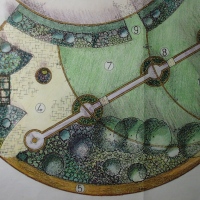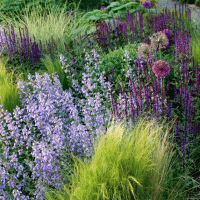Nepeta is a genus of about 250 species of perennials and a few annuals, native to cool and moist to hot and dry habitats in scrub, grassy banks, stony slopes or in high mountains, in non tropical areas of the northern hemisphere. So as you can see, there’s pretty much a Nepeta to suit every garden situation!
Some members of this group are known as catnip or catmint because of their effect on cats – the nepetalactone contained in some Nepeta species binds to the olfactory receptors of cats, typically resulting in temporary euphoria!
They have sturdy stems with opposite heart-shaped, green to grey-green leaves. Nepeta plants are usually aromatic in foliage and flowers. The tubular flowers can be lavender, blue, white, pink, or lilac, and spotted with tiny lavender-purple dots. The flowers are located in ‘verticillasters’ grouped on spikes; or the verticillasters are arranged in opposite groups – toward the tip of the stems.
Nepeta can be drought tolerant, being able to conserve water. They bloom over a long period from late spring to autumn. Some species also have repellent properties to insect pests, including aphids and squash bugs, when planted in a garden. Nepeta species are used as food plants by the larvae of some butterflies and moths and as nectar sources for pollinators like bees.
Nepeta can be grown in any well drained soil in full sun or partial shade. Some species, like N. govaniana and N. subsessilis prefer moist, cool conditions, whereas N. sibirica likes it fairly dry. There are a few tall growing varieties, like ‘Six Hills Giant’, with a more upright habit. These need staking or support to see them at their best. Most Nepetas will rebloom if sheared back after their initial flowering (N. x faassenii and N. nervosa for example). Some won’t provide much of a second show, but their foliage will be refreshed and tidied by the shearing.
Nepeta looks wonderful when covered in flower from early summer. The pale, often lavender-blue flowers perfectly complement the hairy, scalloped and wrinkled, silvery, blue-green leaves. The flowers appear as a haze of blue from a distance. It is often used as an informal, low hedge echoing the colours of lavender (and is used as a substitute where lavender isn’t hardy enough). But it has a rather lax form and will spread itself to cover its allotted space (and more!). Nepeta is best planted at the front of the border, edging a path, so that when you brush past it you will catch the full scent from its aromatic leaves. Nepeta is also a classic underplanting for roses. The colours complement and the foliage hides the ugly ‘knees’ of the rose bush.
We have some here at Old School Garden and this year I’m experimenting with it in some raised planters to try to get a cascading effect, as I’ve seen it used effectively this way on top of an old garden wall in Devon, though I suspect some varieties will have longer stems than others so are better suited to this treatment. The pastel blues of Nepeta combine wonderfully well with pinks and yellows, such as day lilies and yarrow (Achillea). It also looks good with Allium cristophii and Zinnia elegans ‘Envy’.
Some suggested varieties:
- N. nervosa ‘Felix’ – Compact plant with vivid lavender-blue flowers. (12″ H x 24″ W)
- N. x ‘Six Hills Giant’ – One of the tallest growing Nepetas, with lavender-blue flowers.(36″ H x 30″ W)
- N. subsessilis ‘Sweet Dreams’ – Pink flowers with burgundy bracts. Likes a bit more water than most Nepetas. (2′ H x 3′ W)
- N. racemosa ‘Walkers Low’– has 8″ spikes of lavender-blue flowers. ( 2 H’ x 2′ W)
Nepeta is one of those plants that thrives on neglect. Too much fertilizer will only make it grow lots of flimsy foliage. A lean soil and somewhat dry growing conditions will encourage both flowers and scent. Many of the newer varieties of Nepeta are sterile, producing no viable seeds. This is a plus if you don’t like the weedy, self-seeding habit of older Nepeta varieties, but it means you will need to either buy plants or make plants from divisions or cuttings. Division is not a requirement, but if you’d like more plants divide it in spring or in autumn. The Royal Horticultural Society have given it their prestigious Award of Garden Merit.
Sources and further information:
One plant 3 ways- Nepeta design tips
Old School Gardener
If you’ve enjoyed reading this post and others on this blog, why not comment and join others by signing up for automatic updates via email (see side bar, above right ) or through an RSS feed (see top of page)?













